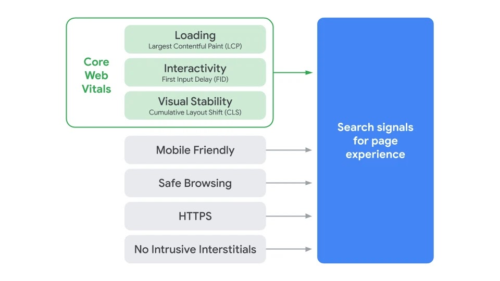
Whether it’s the quality of the content or the experience of the webpage, Google has always said they are in the business of appeasing users. That approach is being reinforced with the announcement of their latest algorithm update: Google Page Experience. Starting sometime in 2021, if Google thinks your webpage provides a bad experience to the user, they may be less likely to rank your website highly in search results.
To evaluate user experience, Google created metrics they believe best quantifies how users interact with web pages called Web Vitals. They are now emphasizing three of these metrics inside Search Console and in a report called Core Web Vitals. These are the factors Google sees as being the best indicator of positive digital outcomes.
Core Web Vitals
Just like a person’s blood pressure or pulse, Google considers these Core Web Vitals to be vital to the health of the website. Like our own vitals, these web vitals are measurable. They include the following:
- Largest Contentful Paint (LCP): marks the point in the load time when the page’s main content has likely loaded. LCP should happen within the first 2.5 seconds.
- First Input Delay (FID): measures the time from when a user first interacts with a page to the browser’s response time to the interaction. (ex: click) FID should be less than 100 milliseconds.
- Cumulative Layout Shift (CLS): measures how often users experience an unexpected layout shift when interacting with the page. CLS score should be less than 0.1, or the 75th percentile of page loads.
When these vitals are out of whack, it’s an example of the website not functioning as well as it ought to be. And this lack of functionality has an impact on site visitors, who can become frustrated and leave.
Core Web Vitals are also not the only signals Google is looking at to determine good user experience. There are other established factors being taken into account as well.
Other User Experience Factors
While not as concretely and directly measurable as the Core Web Vitals, these other user experience factors contribute to overall site health. Google also considers these factors, and so they have importance as well.
- HTTPS – ensures your site’s secure connection by being served over HTTPS.
- Safe Browsing – penalizes sites with hacked content, malware or social engineering content aimed to trick users into doing something dangerous like relieving personal information.
- Mobile-Friendly – evaluates if the webpage is built in a manner that is friendly to mobile devices.
- No Intrusive Interstitials – popups that prevent users from easily accessing the content of a webpage.
This graphic helps explain the factors that Google considers for their page experience score:
With all this said, Google still states the actual content on your site is the single most important factor in ranking. Webpages that have great content but provide poor user experience can still succeed in search results. However, it remains to be seen how much of an impact the Google Page Experience update will ultimately have on rankings. What we do know is it will more heavily weigh page experience, and so it’s important to build your website with this in mind.
What Does This Mean For Your Business?
With page experience factoring into Google’s algorithm this will impact if prospects can find you via search. However, user experience has always been a key component of online customer acquisition. If prospects are searching for a local service and your web page doesn’t load fast enough, they are only a back button click away (resulting in a “bounce”) from all your competitors in the search results. Google has studied this behavior on mobile and have found as page load time goes from:
- 1 second to 3 seconds the probability of a bounce increases 32%
- 1 second to 5 seconds the probability of a bounce increases 90%
Simply put, users have little patience on the web. If you make them wait, they will leave. How fast does your company’s key landing pages load? How do your bounce rates look on those pages? Are you providing the best experience for your prospects across all devices?
Let Go Local Help Navigate The Waters of User Experience
Go Local’s commitment to user experience predates this news from Google. Making our client’s website’s load fast and safe has always been paramount. We’ve built our reputation building lean websites for our clients that provide a good user experience, and our SEO and Web teams can help construct a website that’s good for your users and Google.
Will your business’ web site live up to Google’s new expectations? Are you doing what you can to ensure that your digital marketing efforts are up to par in a world where they are more important now than ever before? Schedule a free consultation with Go Local today so we can keep you ahead of the game.

